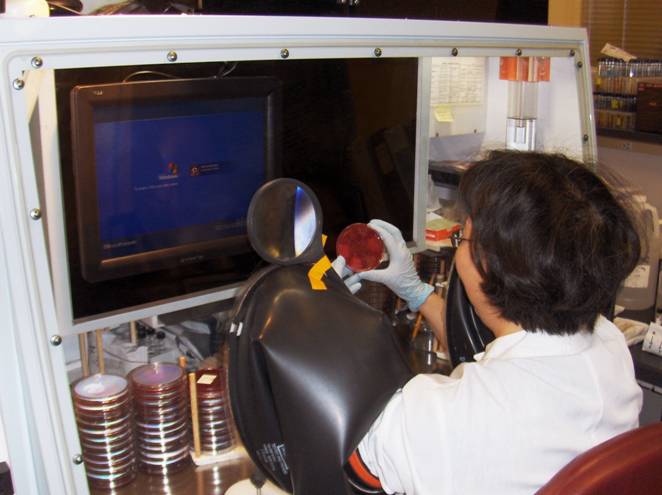 |
|
A clinical laboratory scientist performing anaerobic bacteriology in an anaerobic chamber. |
|
Bacteriology
Routine bacteriology and susceptibility testing:
Experienced clinical microbiologists use microscopy to examine smears of original samples to obtain important early information. Cultures are incubated at optimal temperatures and in special atmospheres to maximize recovery of pathogens. After incubation, they study supportive and differential agar Petri dish cultures of specimens for the colony morphologies suggestive of pathogenic bacteria, the nature of which varies depending on the type of specimen and the source of the specimen. For example, Streptococcus pneumoniae is a pathogen in the blood, but considered a normal inhabitant of the throat. A combination of biochemical and nucleic acid amplification tests (NAATs) are used to accurately identify pathogens to the species level. Pathogens for which antimicrobial therapy is not predictable are tested for susceptibility to antimicrobials using the best possible system for that organism/antimicrobial agent combination.
Etest, anaerobic, and some special antimicrobial susceptibility testing: Supplementary susceptibility methods, including the quantitative agar gradient method (Etest), are used to test organisms with special requirements. In some instances, NAATs are used to accurately detect resistance to provide early therapeutic information. We are also able to test some relatively newer antimicrobials that are not yet represented on most routine laboratories’ systems.
Special studies for cystic fibrosis patient samples: Colonizing organisms can easily overwhelm less robust microbes of huge clinical importance unless special selective media specific for cystic fibrosis patient samples are employed. Microbiology has years of experience handling samples from cystic fibrosis patients and we use NAATs to improve speed and accuracy of results. Additional resources, such as the National Cystic Fibrosis Reference Laboratory, is utilized for further testing where necessary.
Molecular Bacteriology: When conventional bacteriology fails to diagnose an infection or when a quicker diagnosis is needed, molecular biology tools such as mecA PCR and ribosomal RNA gene sequencing are applied directly to the original sample or culture to make an accurate diagnosis.

